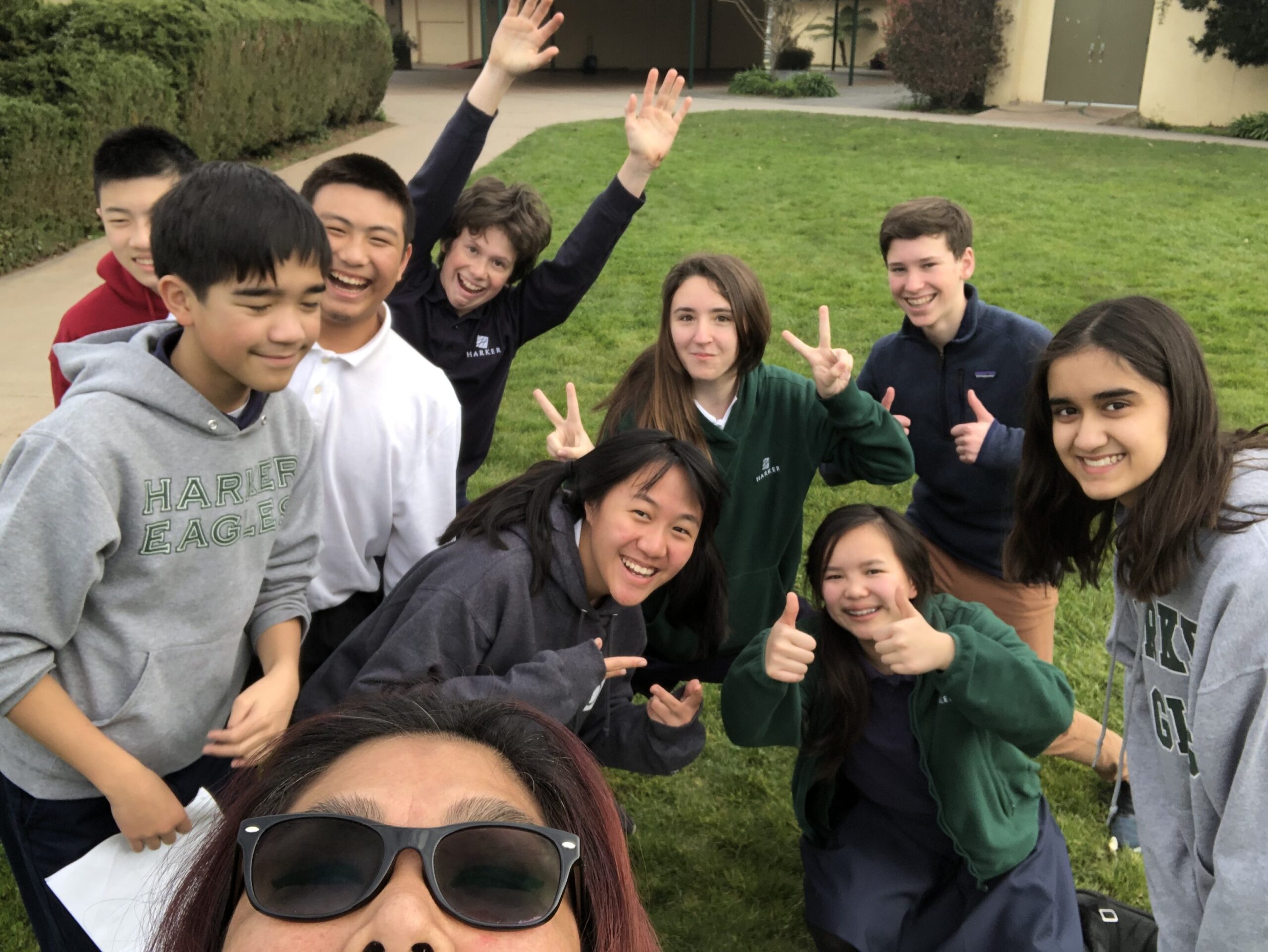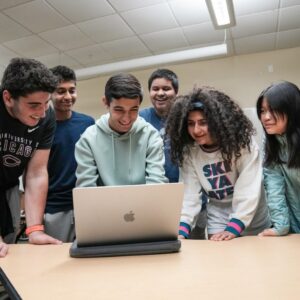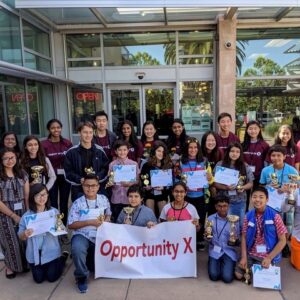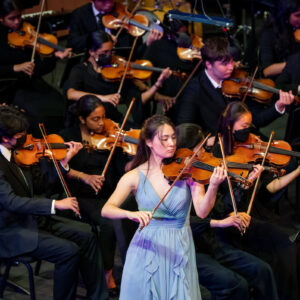This story was originally published in the summer/spring 2019 edition of Harker Magazine.
On a typical day at the upper school campus, a casual observer might notice something that would seem peculiar at other high schools: students wearing T-shirts and hoodies adorned with the names (and sometimes faces) of their teachers, akin to merchandise purchased at a rock concert.
It’s a sign of appreciation for Harker’s long-running advisory program, which has become a crucial component of student life at both the middle and upper schools.
“It’s what makes independent schools unique, I think, particularly a school of our size,” said Kevin Williamson, upper school dean of students. “The advisory program for me helps keep that small school feel.”
At both campuses, advisory is often an opportunity for students to turn their focus away from academics and enjoy some downtime. Students are assigned an advisory – each overseen by a different faculty member – upon entering grade 6, and stay with that advisory through grade 8. Once they enter the upper school, they are placed in a new advisory for the duration of their high school years.
Middle school advisory sessions are held twice a week for 15 minutes each, while upper school advisories meet once a week for 30 minutes. During this period, activities can range from board games to guided discussions to simply chatting about whatever comes to mind, and are largely determined by what students tend to enjoy and what helps them bond as a group.
“The ones I see that work really well are the teachers who are willing to just sit and have conversations with the kids and share some food and laughter,” Williamson said.
Some activities even extend beyond campus. At the upper school, junior and senior advisories often trek to the local Starbucks, and Arabelle Chow’s grade 6 advisees are big fans of boba tea. “We try to eventually get off campus here and there when there’s a long advisory,” said Chow. “It’s such a big deal for them to get off campus [as a group].”
Advisors often find that students feel much more comfortable discussing certain topics within the relatively open-ended environment of the advisory period. “The kids tend to be more themselves in advisory than in a class, where they’re graded, and they’re doing assignments and being tested. There’s a different dynamic,” said Patricia Burrows, assistant middle school head. “In your advisory, if you come in and you have a bad day, your advisor might be someone who can be more tolerant of your mood.”
The beginnings of the advisory program can be traced to the to the start of the upper school, “as early as when Howard and Diana Nichols started visiting schools back East and planning what this high school should look like,” recalled Williamson. “I think the advisory is a big part of what they saw as interesting, and so it started out more as a homeroom, where you’re disseminating information to kids.”
As the school was very small, so too were advisories, made up of an average of just five to six students. As the school grew over the following few years, the administration sought ways to deepen the advisory program while keeping advisories at a maximum of 10 students each. Several faculty members attended a workshop on advisories and returned with “this sort of bible on how to build advisories,” said upper school theater teacher Jeff Draper, who is also the freshman advisory dean. “We did that for a couple of years, then we realized that teachers had a lot of their own ideas and that that book we were giving them didn’t need to be used as much.” Although advisors have considerable leverage over how their sessions are conducted, overarching goals and guidelines are communicated and pursued. At the upper school, these pillars include providing downtime and education on character and ethics, which includes visits by the upper school Honor Council.
Wellness is another key benefit of the advisory program, and in addition to providing a place to destress, advisories also attend talks by guest speakers and workshops in the upper school’s LIFE (Living with Intent, Focus and Enthusiasm) program.
“Having regular discussions about non-academic aspects of school definitely helped me glean various student perspectives,” said senior Kelsey Wu. “As a member of student council who focuses on promoting mental health at school, student happiness is really important and valuable to me. Advisory is also a great outlet for stress, as it’s a time designated to purely have fun.”
Family Bonding
Each advisory also spends one day each year on a special outing to foster teamwork and bonding. Incoming freshmen enjoy their orientation day playing team-building games on Davis Field. During sophomore year, students traverse ropes courses in Santa Cruz and La Honda, and juniors go whitewater rafting. Just days before graduation, seniors embark on the senior trip to reminisce before the end of their high school careers.
“Orientation Day involves a lot of field activities, and one that really stands out to me was the water pipe activity. Essentially, every advisory got a vertical PVC pipe with water in it, but the pipe had holes that advisory members were only allowed to block with their bodies,” said Wu. “It was a lot of fun, and a great bonding experience for us.”
The early class outings are a crucial way in which students connect, as they drive home the importance of supporting their fellow advisees. “[The ropes course trip is] a time when advisories work as a team and troubleshoot, problem-solve and also have to support each other – literally carry each other’s weight as half the group is climbing in the trees and the rest are belaying, helping them hold the ropes,” said Draper. “And that metaphorical idea of being supportive, when it’s literal, all of a sudden they feel it and I just can see the groups being closer the next day.”
As their years together draw to a close, the senior trip provides a way for students to close the loop on their advisory experience. “Days before graduation, they are with their advisory groups for a lot of that time, and it’s just this miniature family that has clicked over the years,” Draper said. “And it’s a really positive part of what I think the Harker experience is.”
Overall, however, advisors have discovered that the character of their advisories can change drastically with each new class, and that different classes receive the benefits of the advisory program in various ways.
“My last two advisories loved playing games,” said Nicole Hall, the upper school administrative services manager. “So I thought [with my current advisory], I’ll make sure I have a lot of games. But it turned out they’re not really into games. So it definitely took some time to find what would work for them, and they tended to really like just having discussions.”
Both the middle and upper school programs place advisors in the role of guides and advocates who can be consulted when students have questions about their academic path or when disciplinary issues arise. “We have [one-on-one] discussions with the kids about changing maybe from honors to AP or vice versa,” said Williamson. When there are disciplinary concerns, “as an advocate, it doesn’t mean I’m their defense attorney. I just want to help [them] figure out how to address the concerns this teacher has.”
Chow stressed how important it is for students to feel like advisory “is a home base, and they’re not going to get in trouble for things, and I’m there to support them rather than knock them for things that they might not be doing right.” Although advisors are notified when a student has a disciplinary problem, the ensuing discussion “is about ‘what could we have done differently’ instead of ‘I can’t believe you did this.’”
The “home base” aspect of advisory is talked about often at the middle school, where the program is similar to the upper school’s in that it provides a nonacademic space where students can receive support and participate in various activities. “It’s a home base for students to have a place to consistently meet an adult who provides some guidance for them,” said middle school Spanish teacher and advisory dean Julie Pinzás. “Sometimes they discuss what happens around school, their everyday adolescent fears; study strategies are sometimes incorporated.”
Wu, who became a Harker student at grade 5, enjoyed the idea of advisories from her first days at the middle school. “Having a smaller group of eight to 10 students in which mental health, student stress, and just plain fun is prioritized was really refreshing,” she said. “I think something like this is really valuable at a place like Harker or even the wider Bay Area, where students are very driven and passionate about their own goals.”
Advisories at the middle school have more direction from advisors, who often have their advisees engage in activities that involve telling the other members of the advisory about themselves. “In my advisory we have students present about themselves to start us off,” said Pinzás. “They include their families, what they did during the summer, their likes and dislikes, some of their hobbies.”
Chow’s advisees also do presentations about themselves and bring along snacks to share. Often these snacks have some importance to them, such as being a part of their cultural background or something they enjoyed growing up. “They’re kind of responsible for sharing about themselves with advisory, and they tend to bring snacks that are connected to them in some way,” said Chow.
Avi Gulati, a junior who started at Harker as a third grader, remembered one middle school activity that helped him grow closer to his fellow advisees: performing a dance routine to Justin Bieber’s “Baby.”
“We were all Beliebers,” he recalled. “Although our dance was initially uncoordinated, with practice – a lot of practice – we soon mastered the routine. This is the capstone and one of the defining memories of my middle school advisory experience.”
Middle school advisors periodically receive new guidelines on what to work on with their advisories. Recently, advisories have emphasized that students are more than their grades. “We are having them think about what they do outside of school and their interests,” said Pinzás. “They are a brother, a son, a friend, a basketball player.”
“Obviously grades are important, but we want them to think about what else they bring to the table,” said Chow. “It’s also another opportunity to get to know what they do outside of school, because they’re so involved in so many things, and we just never know about it. Oh, you’re a top fencer, and I had no idea!” The middle school advisory also includes the house system, which was introduced in 2008 to help middle school students in different grades connect with one another. Within each house, sub-groups of three students from each grade were introduced this year, “because we want students to be able to get to know other grades as well, and there are some challenges with that,” said Burrows.
Houses compete each year for spirit points, but there are also cross-grade activities designed to foster connections between students in different grades. “They’re not just one grade, but several grades, and they work together and they benefit from each other’s strengths,” said Pinzás. “It does help them see that there are other people out there, other than the students in their grade.”
Avenue for growth
Students have found that advisories have helped them stay up to date on school events in addition to being an opportunity for play and relaxation. “Advisory helps a lot with keeping up with announcements and other assemblies during the week,” said Keren Eisenberg, grade 6. “I also find it very fun and relaxing to have 15 minutes in the day to do nothing and play around a little bit.”
Sixth grader Harriss Miller appreciates how advisories help him keep track of things like assemblies. “Also, the time I have in advisory is very soothing. There is very little work required for advisory, and it is great for relaxing,” he said.
This year, middle school advisories have begun to further incorporate social-emotional learning to help students learn more about themselves and in turn become better at understanding others. “When we talk about social-emotional learning, we’re talking about things like self-awareness, self-management, self-regulation, interpersonal relationships,” Burrows said. “Those are the kinds of skills that we have the opportunity to develop in advisory.”
“It’s my goal as an advisor that my kids are all just really good people,” said Chow. A recent advisory activity involved creating a chain-like display honoring social justice heroes, which led to a discussion about “why it’s important to use language that’s not hurtful to people.”
These experiences are important to help students navigate conversations involving topics that are often uncomfortable to discuss. “You just have to embrace that discomfort, and figure out how to have the discussion in a mature way,” said Chow.
Burrows identified advisories as an “important avenue” for teaching students social-emotional skills. “It’s in advisory that you can have the conversations about being a better person,” she said.
One reason the advisory may be so well suited to learning how to empathize with others is that students are put in direct contact with other students they may not have otherwise met. “Their best friend might not be in the group,” said Pinzás. “They’re mixed up a little bit so that they can have an experience with a different group of people and learn how to cooperate and work together.”
According to Burrows, creating those connections with others and learning to work through the differences and problems that may arise in bonding with students they may not normally interact with is central to the mission of the advisory program. “When they move into high school, where things are less structured, and with less guidance, they have some tools to make decisions that will be healthy for them,” she said.
Even with those tools, transitioning to high school life can be a challenge. Making this adjustment easier for incoming freshmen was a primary reason Draper became freshman class dean in spring 2018. “I get to help them with that first thing, getting started in high school and feeling safe, secure, happy, meeting friends, knowing how this all works, and then feeling like they’re at home as early as possible,” Draper said. Of great assistance in this task is the Link Crew, a group of Harker juniors and seniors who act as guides and mentors to freshmen, visiting and running advisories several times a year as well as being available to answer questions and listen to concerns.
“We have so much student leadership at this school, and they’re empowered and they want to help each other out; they problem-solve and they work together, and they collaborate with each other, and with the new students,” Draper said. “And it’s just fun to watch that whole program work and run as well.”
Students’ appreciation for what they do and learn in advisory extends well beyond wearing personalized attire during the school day. “At the end of the year, the seniors create a card and shout out to teachers and administrators who they really connected to,” Williamson said. “The thing that gets mentioned more than anything else is advisory. They’re so grateful for their advisory group, for their advisor.”
Wu, who was in Chow’s advisory during middle school, greets her former advisor whenever they cross paths. For Chow’s part, visits from advisees who have gone on to the upper school or graduated is something she has come to expect. “The ones who always come and visit me from the high school or even after high school are my advisees,” said Chow. “Even though you don’t see them every day, it is one of those relationships that’s super strong and they tend to remember after leaving Harker.”
For Gulati, the benefit of the support system gained from advisory cannot be overstated. “I can’t stress how important it is for students, especially in middle school and high school, to feel like they’re a part of a group of people that supports them,” he said. “That’s the goal of advisory. It’s such a regular part of my schedule … that I overlook how meaningful it is.”







